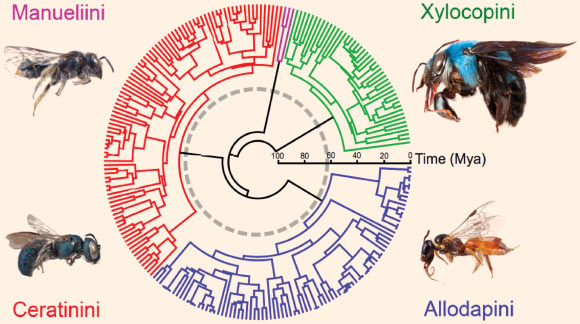Researchers from Australia and the United States have documented a massive extinction among bee populations, concurrent with an event that wiped out dinosaurs and many flowering plants 65 million years ago at the end of the Cretaceous and beginning of the Paleogene eras (K-T event).

This chronogram shows a pattern of early diversification in Xylocopinae bees, followed by a long period during which development effectively stalled, and then followed by further rapid diversification. The K-T boundary is shown in grey. Image credit: Rehan SM et al.
“Bees fossilize very poorly, and their presence in the fossil record is very patchy,” said Dr Michael Schwarz from Flinders University of South Australia in Adelaide, who is a senior author of the study published in the open-access journal PLoS ONE.
There is a concentration of fossilized bees in amber from 45 million years ago, but earlier bees are scarcely represented in the record at all. The fossil record does, however, indicate disruption in the evolution of flowering plants consistent with the K-T event.
Unable to rely on fossil evidence for bees, the team turned to a technique known as molecular phylogenetic analysis that extracts fragments of bee genes and, in effect, enables scientists to track paths of genetic development retrospectively.
Analyzing DNA sequences of 230 species in four tribes (Ceratinini, Allodapini, Manueliini and Xylocopini) of the bee group Xylocopinae from every continent except Antarctica for insight into evolutionary relationships, they began to see patterns consistent with a mass extinction.
Combining fossil records with the DNA analysis, they could introduce time into the equation, learning not only how the Xylocopinae bees (carpenter bees) are related but also how old they are.
Study lead author Dr Sandra Rehan from the University of New Hampshire said the data told us something major was happening in four tribes of carpenter bees at the same time, and it happened to be the same time as the dinosaurs went extinct.
“When we find that something is affecting all of them in the same way, you have to ask what that would be,” Dr Schwarz added.
“What we found was a genetic signature that is exactly what you would expect for a massive extinction event, and it corresponds very closely in time with the extinction of the dinosaurs.”
“Because bees are the main pollinators of flowering plants and their evolution is closely linked, the implications of extinction of bee populations are profound, and would have had major consequences for flowering plants as well as the subsequent evolution of bees themselves.”
“Understanding extinctions and the effects of declines in the past can help us understand the pollinator decline and the global crisis in pollinators today,” Dr Rehan concluded.
______
Bibliographic information: Rehan SM et al. 2013. First Evidence for a Massive Extinction Event Affecting Bees Close to the K-T Boundary. PLoS ONE 8 (10): e76683; doi: 10.1371/journal.pone.0076683







